Over the next few months, we’ll be taking the OP4 to Victoria's High Country several times, to see what cold-night sleeping is like as well as into the Red Centre to see how it handles corrugations, dust, and wind. First though, a recap on the OPUS OP4.
As recently as issue #161 we looked at the OP4. That issue was in Redarc’s Camper Trailer of the Year where the trailer was judged by four of the best in the bush and beaches around Port Macquarie. Although it didn't take any wins, it did well. Innovation was strong as was X-factor — no doubt driven up in our ratings by the star of the show in the form of inflatable top-sides.
The highlight of the OP4 is the setup process, or lack thereof. The inflatable trailer is unique and it’s pretty damn impressive to watch it do its thing. With pros at the latches and switchgear, we timed from lids down to full set up in about seven minutes. Outrageously good for anything bar a walk-in hybrid.
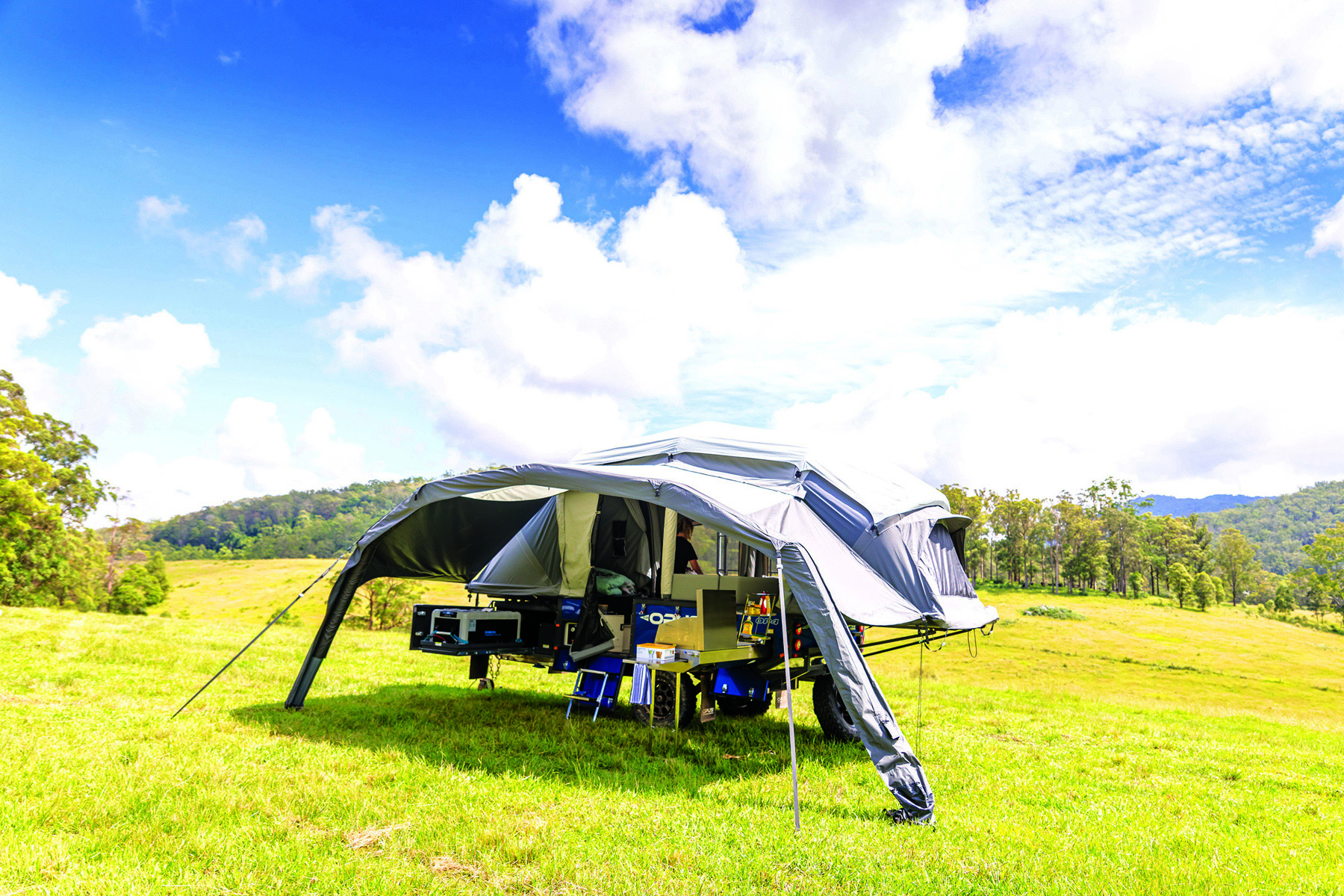


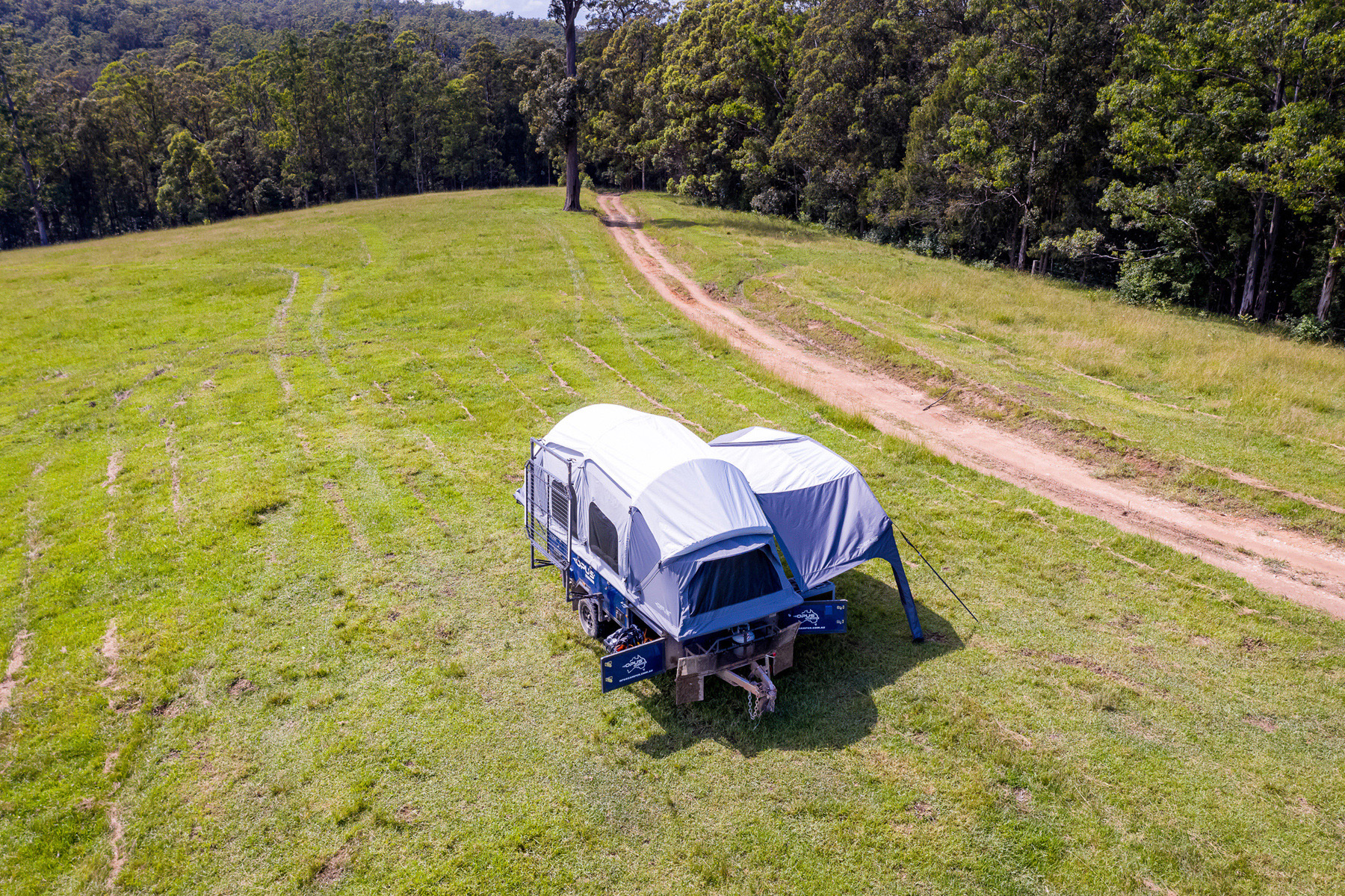

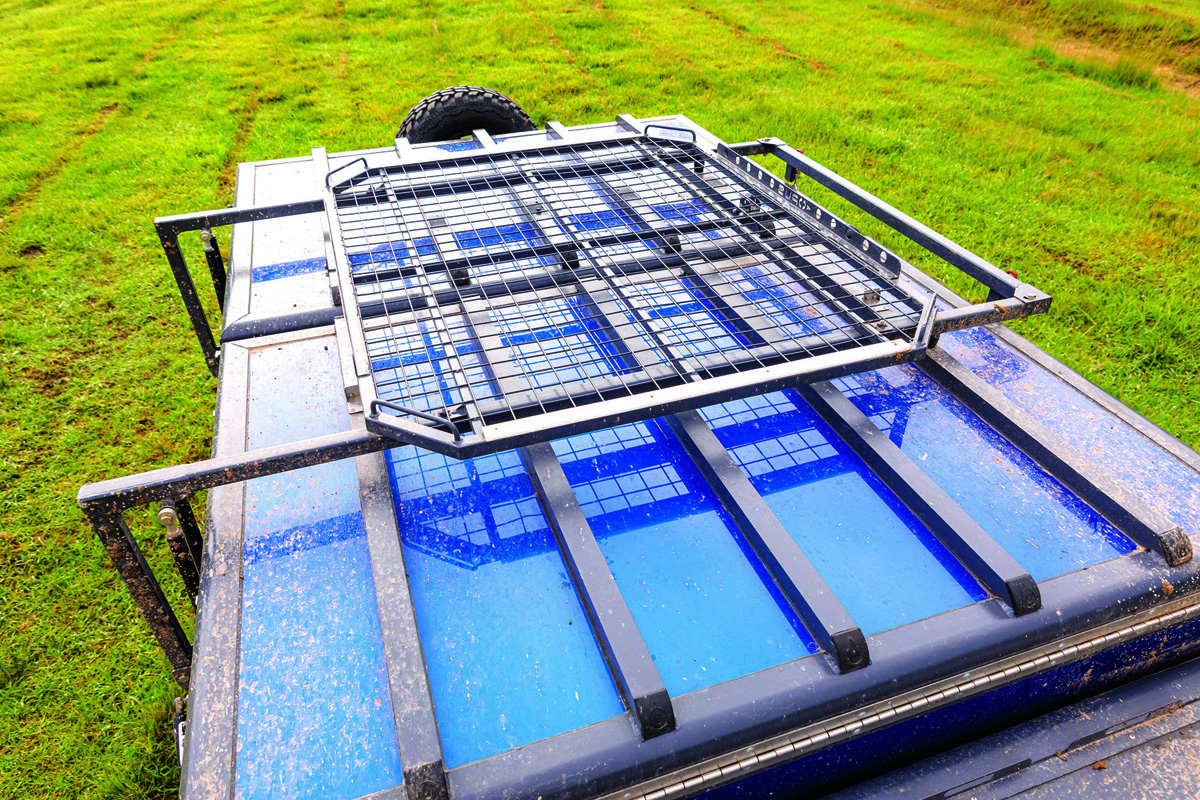


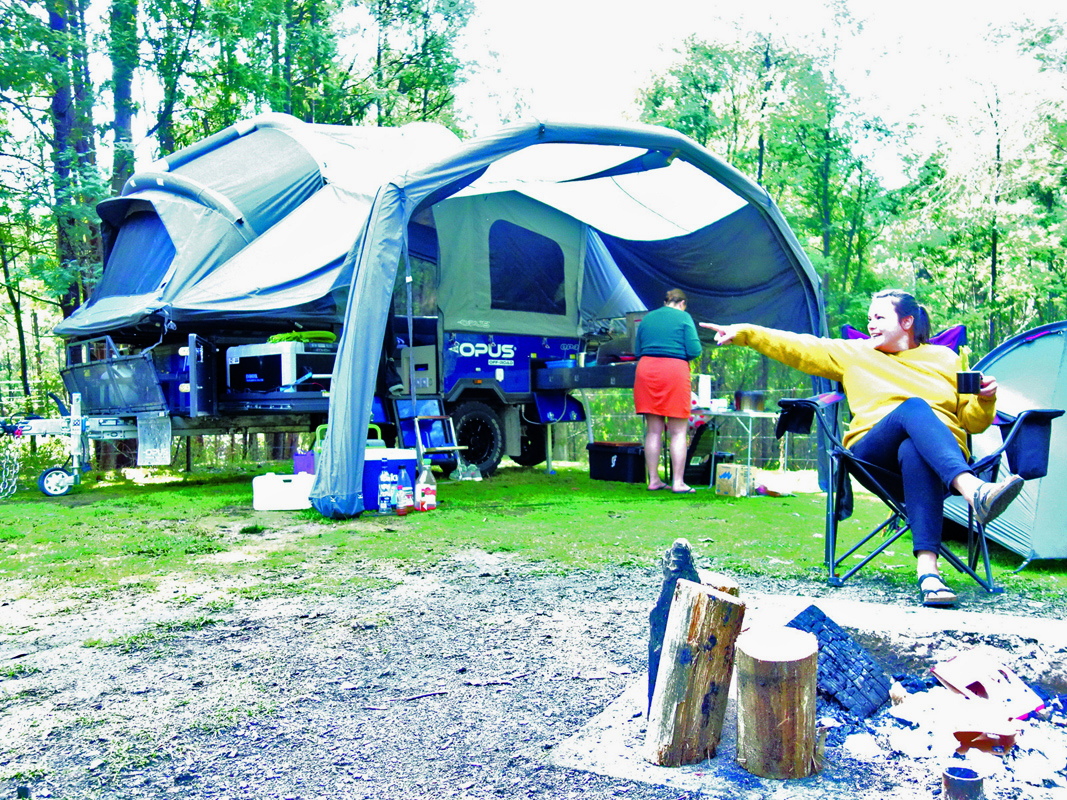
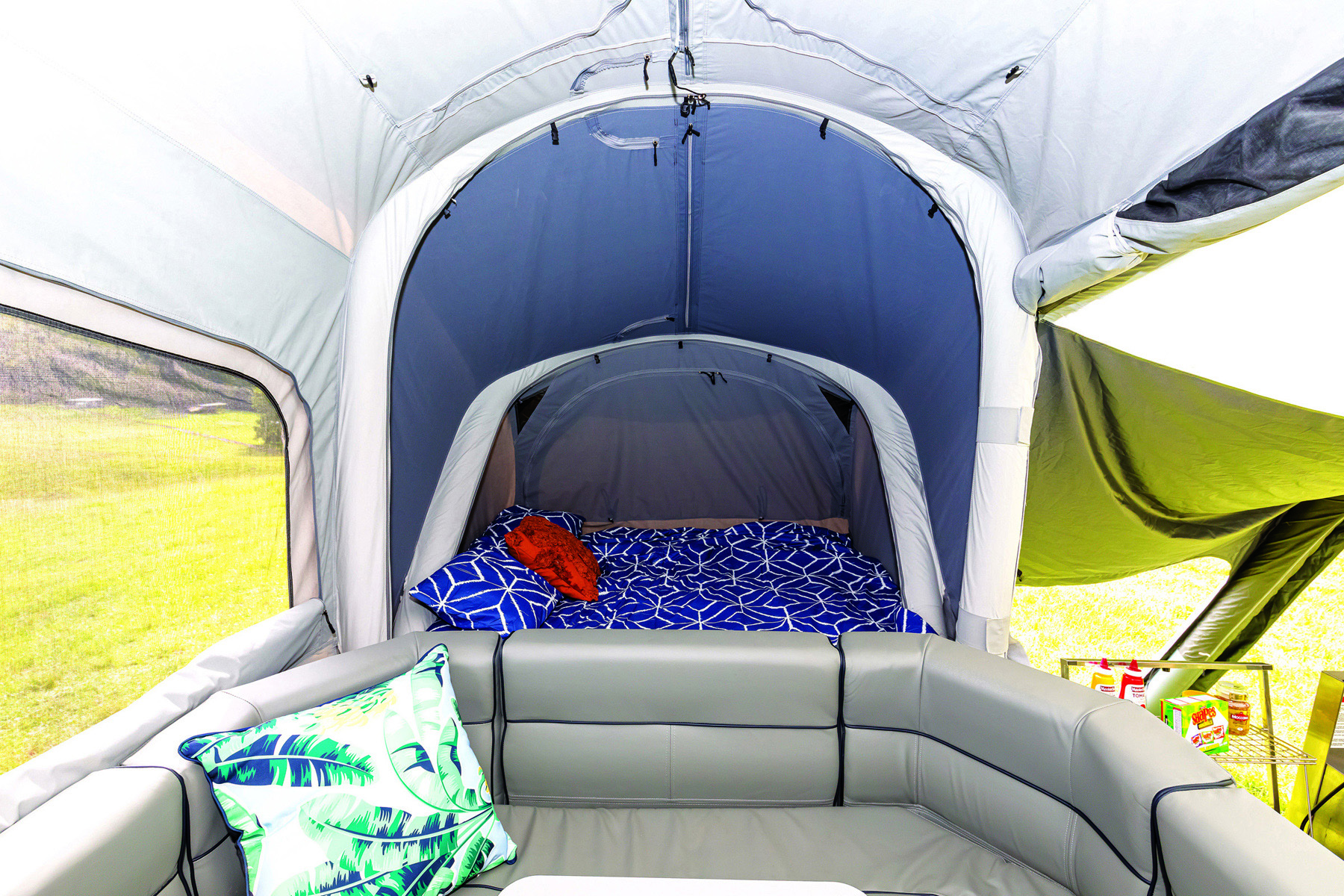
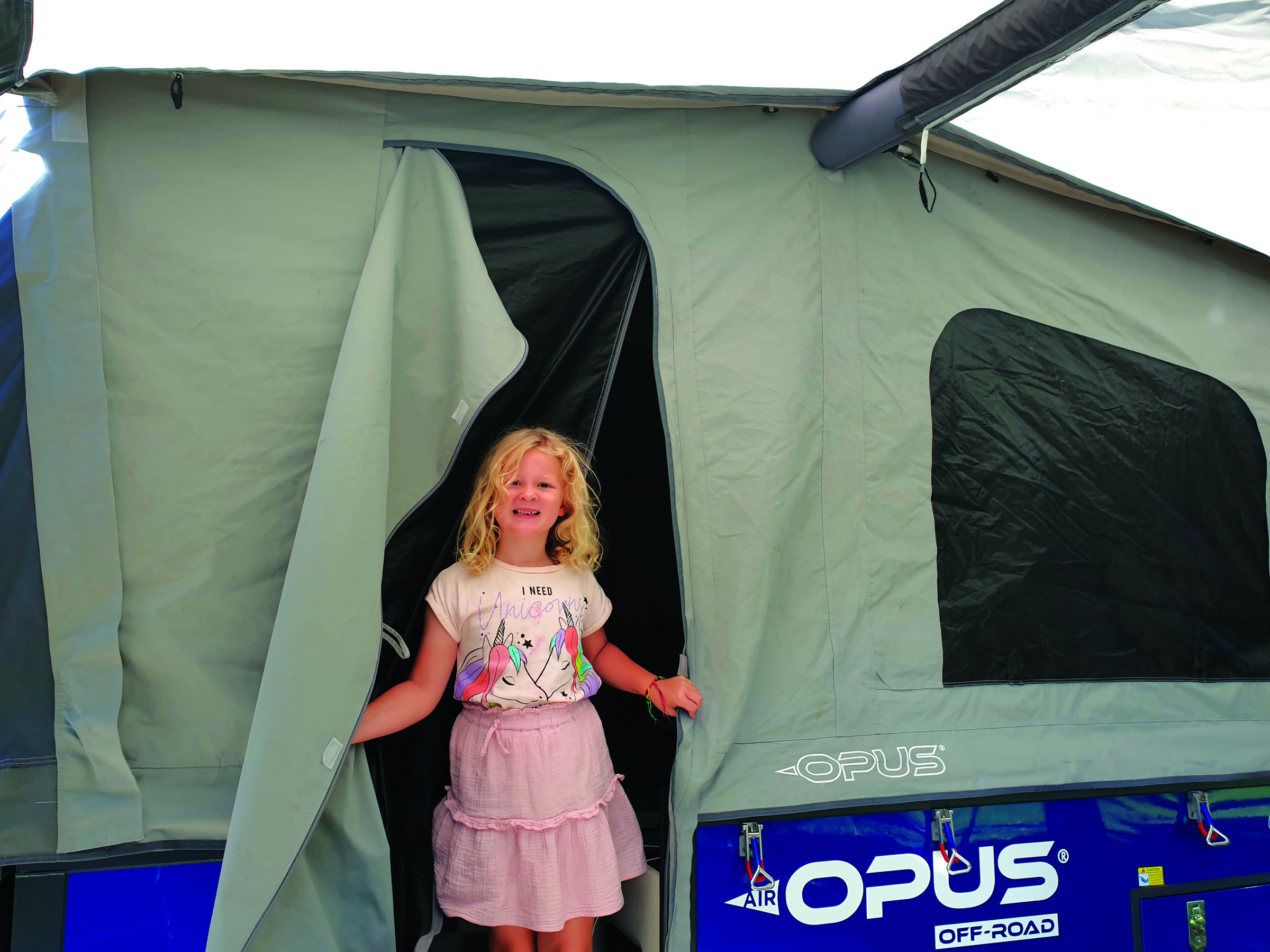
The OP4 is a double fold, opening in the centre with a central entrance and rear kitchen and front fridge locker. The layout is familiar with a central lounge complete with a good number of 12V charging options and tubes for LED light strips.
 Set up is quick and easy
Set up is quick and easy
Ours is clad in blue composite panels over an alloy frame with galvanised steel chassis. The blue looks smart, as do the OPUS branded alloy wheels which tie into the grey, hard-wearing coating applied to the joins and leading edges of the body.
Weight is pretty good considering there is a shed load more in the 340gsm micro-weave canvas tent than typical campers. ATM is 1990kg and tare is about 1455kg with the boat/roof rack leaving around 550kg of payload. Gas capacity is by way of twin 9kg bottles and water totals 160L. There is no solar as standard, nor a HW system and the BMS is 240V AC for charging the twin 100amp AGM batteries or direct line Anderson plug.
The undersides are fairly recognisable, with everything from the tent down imported. The trailing arm suspension is familiar, and the chassis looks well enough made and finished for the aggressive price point.
Pricing starts at as little as $30k excluding on-roads, with the test camper coming in $2000 more thanks to a great quality ARK jockey wheel, LED strip lighting, and boat/roof rack. There is room to add a bit more on — the obvious ones being a hot water system and a more capable BMS system, but even with those ticked and your favourite fridge, you should still come in at less than $35,000. Pretty good value for a camper with such a huge amount of investment in the clever tent system.
 Mud terrain tyres were good in the slippery High Country
Mud terrain tyres were good in the slippery High Country
A five-year warranty covers the body and chassis while the tent carries a three year warranty. Appliances added locally — fridges, hot water systems and so on — carry their manufacturer warranty over.
Now that the basics are covered, we get to our testing regime. After an incident-free tow from the central New South Wales coast, we had the OP4 at our Braeside, Victoria warehouse before straws were drawn for who got to go first. It was Tim who came up trumps.
TESTING TIMES
Words Tim van Duyl
The weekend after the OP4 arrived, I had the keys and the first trip was a proper shakedown with a testing drive into Talbotville, one of my favourite spots in Victoria's High Country.
The route I prefer takes in the seven or so river crossings along Crooked River, although it is more challenging to tow along, especially along the sections where it skirts old mining camps. On one such section I came along a convoy that asked me to back up 100m as it seemed easier to them even after I mentioned I was towing. Luckily my first job was towing a trailer, and I still do it enough to nail it the first time to the admiration of the onlookers. (Editor’s note: this is Tim’s claim and we have no proof he nailed anything.)
The tow was pretty straightforward. I had to work my old ‘99 LC to keep up with the rushing Melbourne traffic around the city skirts but once out of town, I could cruise happily with no issues. The brakes worked well with my Hayman Reese controller and the optional DO35 hitch was quiet and fuss-free.
 Getting to and from the king bed requires dismantling or crawling over the lounge
Getting to and from the king bed requires dismantling or crawling over the lounge
Once I turned off Dargo Road things started to get serious. I knew the region had seen some rain in the previous week — part of the reason I came this way is that I wanted to test how the camper handled the drop-offs into Crooked River with the surrounding slippery, wet clay and see whether the automotive grade seals used on all lockers actually held up to a dunking. Grip was never an issue with the MTs on the trailer and car and the camper’s corners stayed clear of the worst rocks and ruts, but I’ll admit it was close, and I wondered how I’d explain damage on the first trip — but we survived. On water ingress, one crossing had water splashing over the bonnet of my lifted ‘yota which saw water lapping against the up-river side of the camper. Jumping out to check, no meaningful amount of water made it in the lockers — just some dribbles around the latches. Tick.
Once at Talbotville, I gave the reins to Erin, my primary caregiver and wife. I had experience setting up an OP4, so wanted to see how easy it was to the layman. I kid you not, Erin had us set up in 10 minutes, and this was well after dark. All I had to do was check if a couple of beers were cold, point out where things lived, and plug in the LED light strips that had slipped out of their pockets. It helps to be tall here, or stand on the beds/table. Our only slip up was the button to turn on the compressor failed — a simple fix that has been remedied on future trailers.
We hit the sack immediately, choosing the queen bed as opposed to the king as it had an OPUS-supplied ‘pod’ that adds a layer of protection from bugs, and we didn't want to risk getting our blood sucked. The high-density mattresses are good; we never felt cold underneath and even if not as comfortable as a household mattress, we got to sleep quickly.
The next two days slipped by quickly. More rain fell but the tent never leaked. We didn't carry solar and left the car unhitched. We saw around 2.5–3A draw with the optional MyCoolman 90L fridge idling and lights on. After two days the gauge told us we had 50% battery left.
FAMILY FAVOURITE
Words Rob Gallagher
 Georgie for scale showing the door is a good size
Georgie for scale showing the door is a good size
My first encounter with the OP4 was a 4000km round trip drive to Noosa, Queensland with my girls in a borrowed Hema-branded Prado. The Prado handled the journey with ease. I hardly realised we were towing the OPUS, and its towability is simple and uncomplicated.
One of the blessings of the OP4 is the simplicity and speed of the setup. On a number of the legs between Melbourne and the Sunshine Coast we did some decent driving days which meant we would turn up at our campsite at random times. The best example was our detour via Dorrigo to Dubbo when we arrived around 11pm, with both of my girls fast asleep in the back.
I was able to arrange the late check-in at the campsite, park the rig — viewing angles for the camper reversing were pretty good given I was often a one-man band parking — and start the setup. Despite it being pitch black, I was able to unhitch, open up the camper, press the 'inflate' button and presto — within 15 minutes we were ready to go.
The inflatable tent makes it so simple to set up as one person as you are not having to fiddle with poles and screws. Simply letting the air pump do its thing while unpacking the car and getting the other bits and pieces tidied away means by the time the tent was fully inflated, you could get to bed without fuss.
With two good sized double beds and a sofa area, the OP4 has good space to rest and regroup at night. Though the layout of the camper meant there are limited storage spots for the kids' bags and access to the rear bedroom is clumsy with the lounge set up.
 The tent is sturdy and provides great cover even in the midst of a storm
The tent is sturdy and provides great cover even in the midst of a storm
The folding table became a great outdoor centrepiece under the awning. The slide out MyCoolman fridge didn't miss a beat and with dual controlled sections we were able to keep the beers super cold. One thing lacking in the outside area is some bench space and some functional storage for the cutlery and other kitchen necessities.
The tent itself was very sturdy and provided great cover — especially on a couple of days when we got stuck in the midst of a sub-tropical rain storm. It was saturated outside, but cosy and dry in the tent. The seals worked well and the zip-up windows, fly screens, and block-out screens gave the girls that happy mix of letting the light in and having private time.
The entry door was functional and simple to put up and down, but in the evening it would be good to be able to close and seal the door to avoid wind and critters making their way in.
The awning is sturdy, and with only a couple of tent pegs, it handled some relatively tricky winds without missing a beat. The shade and extra room it provided straight off the bat on set up was perfect, especially on the days where I set it up in the wet.
Having got the hang of the pack down after a couple of attempts, the process is very simple and easy to do. The trick is getting your order right for releasing the air valves and making sure the tent is lined up in the right spot as it collapses, allowing you to simply fold over the two ends and, without much elbow grease, have them secured and fastened and the camper all ready to go.
I might not get another run with the OP4 as the queue is long, so here are my closing thoughts. As anyone that travels with kids will know, the functionality of the camper beats looks every day. The ease of setup and towability suited long distance touring with my girls fantastically well. As OPUS refine and develop the range, some extra polish around the kitchen and couch areas will make them that little bit more appealing for family adventures.
 The optional boat roof rack is a good option for the asking price
The optional boat roof rack is a good option for the asking price
SPECS
Tare 1370kg (or 1455kg with roof rack)
ATM 1990kg
Payload 620kg (or 535kg with roof rack)
Ball weight 140kg
Suspension Independent trailing arm with coil springs and dual shocks
Brakes 12in electric, plus handbrake and electrical breakaway
Coupling Articulating polyblock
Chassis/drawbar Galvanised steel
Frame Aluminium frame with composite panel exterior
Wheel/tyre 15in alloy wheels, 235/75R15 offroad tyres
Tent canvas 340g Micro-Weave Polycotton (tough tent)
Style Inflatable dual fold
DIMENSIONS
Dimensions (closed) 5600mm inc. spare tyre (L) x 2150mm (W) x 1450mm (H)
Dimensions (set-up) 6140mm (L) x 2100 (W) x 3200mm (H)
Approximate footprint (setup with annexe) 6190mm x 4215mm
OPTIONAL ACCESSORIES
Water 2 x 80L tanks plus with 2 x 12V pumps, plus 2 x 20L jerry can holders
Gas 2 x 9kg holders
Kitchen Stainless steel with four-burner, wind guards, sink, rack, extendable working space and cutlery drawer; separate slide for 61L fridge (soon there’ll be room for a 95L model, plus pantry space)
Battery 2 x 100Ah AGM batteries with 240V charger standard
OPTION FITTED
Roof rack; LED light bar kit; ARK XO 750 Offroad Jockey wheel; King Bed Infill Cushions
PRICE AS STANDARD
$29,990 (excluding on road costs)
PRICE AS SEEN
$31,039
ENQUIRIES
Opus Campers
Address 22 Mills Road, Braeside, VIC 3195
Phone (03) 9588 2959
Email enquiries@opuscamper.com.au
Web opuscamper.com.au




